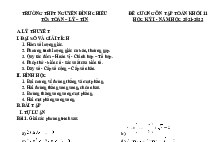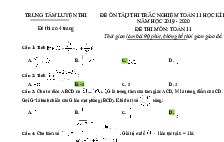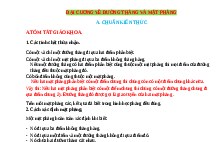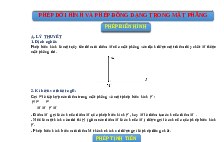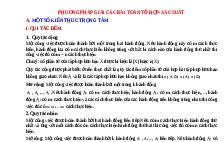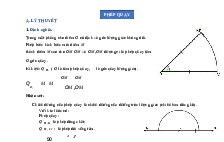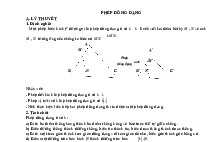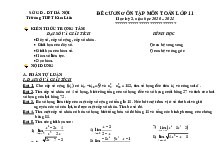Đại số 11 Chương III. §2. Dãy số
Nội dung tài liệu
Tải xuống
Link tài liệu:
Các tài liệu liên quan
-
![Đề cương ôn tập học kì 1 Toán 11 trường THPT Nguyễn Đình Chiểu năm 2021-2022]()
-
![Đề cương ôn tập trắc nghiệm Toán 11 năm 2019-2020]()
-
![Hình học 11: Đại cương về đường thẳng và mặt phẳng]()
-
![Toán hình 11: Phép tịnh tiến]()
-
![Toán 11: Qui tắc đếm]()
-
![Toán hình 11: Phép quay]()
-
![Toán hình 11: Phép đồng dạng]()
-
![Tài liệu ôn tập HKII năm học 2020-2021 môn Toán 11, trường THPT Xuân Đỉnh - Hà Nội]()
-
![Đề cương ôn tập HK2 Toán 11 năm 2020 – 2021 trường THPT Kim Liên – Hà Nội]()
-
![Nội dung ôn tập HK2 Toán 11 năm 2020 – 2021 trường THPT Trần Phú – Hà Nội]()
Có thể bạn quan tâm
Thông tin tài liệu
§2.§3.§4.§1.§1.Review onsider (v)- xét, coi. contain- chứa. rop ortion-mệnh đề Induction-quy nạp.v ariabl -biến. Deduction-suy diễn.element- phần tử. Deduce (v) -suy raassume/suppose(v)-giả thiết. Equality-đẳng thứcrelation-mối quan hệ. term-số hạng New words N* every belongs to natural numbers, not zero.x to the (power of) squared. A>B: is greater than B, is less than cubed. M=N: equals to A(n): of n. 3.x: three times x. 4/x :four over xLHS: left hand side, RHS: right hand sideActivity a) For 1,2,3,4,5 are P(n), Q(n) true or false b) N*, are P(n) (n) true or false P(n): >3n +1 và Q(n): “3n nơ N*2n Consider two proportion containing variables, (variable n)P(n) 3n+1 Q(n) ”Group ActivitiesConsider two proportion P(n) 3n+1 and Q(n) a. For 1, 2, 3, 4, are P(n), Q(n) true or false?b. For every N* are P(n), Q(n) false or true ?Answer :a. P(n) 3n+1 Q(n): 3n+1123453 nn n123452nb. For every N* P(n) false Q(n) we can not sure to say false or true, because we can not check /have not checked for all N* 392781243 47101316 281632 543214 TTTT TTTTTFFor =1;2;3;4;5P(n) false For =1;2;3;4;5Q(n) true Note: To prove that proportion is FALSE we need show at least one case. To prove that proportion is TRUE we need show that it is true for all. For N* when we have checked for many number (not all), that is not proof.Hence, Mathematical Induction method of mathematical proof used to establish given statement for all natural number is an important and effective method in mathematics.§1. MATHEMATICAL INDUCTION Step :Step Check to make sure that the proportion is TRUE for Assuming that the statement is TRUE for any natural number (called induction hypothesis ). I. Mathematical Induction:Prove that it still holds for 1. (Using induction hypothesis and all true statements)Step :Prove that for N* then: (2n 1) (1)Proof 1) For the left side has only one term equal to 1, the right side equals to1 2. Therefore, (1) is TRUE 2) Set the left side of (1) equal to Sn Assume that the equation is true for that is Sk (2k –1) induction hypothesis 3) We have to prove that (1) still holds for k+1 xample1 :II. Examples:Sk+1 …+ (2k 1) [2(k 1) 1] (k +1) 2Infact, by the induction hypothesis, we have Sk+1 Sk [2(k 1) 1] 2k 1) Therefore, relation (1) is True for every N*.Prove that for every N*, is divisible by .Solution: Set An (1)1) For then: A1 0… 2) Suppose that (1) is true for we have:Ak (k k)… induction hypothesis )3) We must prove Ak+1... Ak+1 (k+1) 3 (k+1) +3k +3k +1 1= (k 3 k) +3(k 2+k)= Ak 3(k 2+k)Ak… (k 2+k)...3 hence Ak+1… .We conclude that An is divisible by for all N*. Ví 2:ụ Example 2Prove that for nProve that for nN*N*Prove that for all N* then un 13 –1 6…Activity 2: Group ActivitiesGroup Activities 1)1 ... (1)2n nn


